Category: Amazon Pinpoint
Catching Up On AWS Announcements from Early 2017
Even though we have published 123 posts so far this year, we simply don’t have the time to cover every significant AWS launch. Also, the newer services are often richer and take more space to describe, adding to our workload. This post (and others to follow each quarter) will outline some of the launches that we did not have time to address earlier.
So, here we go:
- Migration Support for NoSQL Databases
- Comments, Tagging, and Metadata APIs for WorkDocs.
- Email and SMS Integration for Pinpoint
- Usage Type Groups and Linked Account Access for AWS Budgets
- EC2 Systems Manager Support for Hierarchies, Tagging, and CloudWatch Events
These features have already launched and you may already be using them!
Migration Support for NoSQL Databases
With this launch, AWS Database Migration Service can migrate relational databases, NoSQL databases, and data warehouses. The launch adds support for MongoDB databases as a migration source and Amazon DynamoDB tables as a migration target. To get started, create a replication instance and database endpoints for MongoDB and DynamoDB:
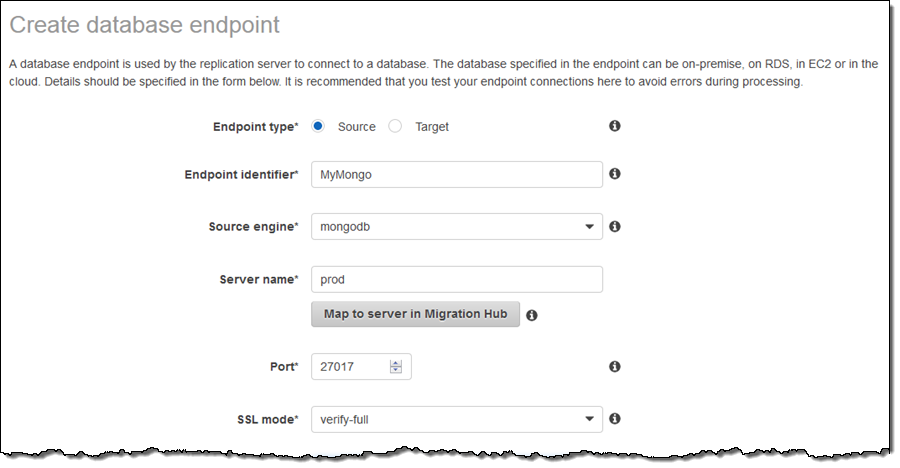

Read MongoDB as a Migration Source and DynamoDB as a Migration Target for more information.
Comments, Tagging, and Metadata APIs for WorkDocs
This addition to the Amazon WorkDocs Administrative SDK provides APIs for creating and accessing metadata, tags, and comments:
Metadata – CreateCustomMetadata, DeleteCustomMetadata.
Tags – CreateLabels, DeleteLabels.
Comments – CreateComment, DeleteComment, DescribeComments.
The SDK is available for Java, Python, Go, JavaScript, .NET, PHP, and Ruby. It handles signing of API requests using Sigv4, and is integrated with IAM (roles and permissions), SNS (real-time notifications), and CloudTrail (monitoring).
Email and SMS Integration for Pinpoint
In addition to the existing Mobile Push Notifications, Amazon Pinpoint can now drive user engagement through email and SMS notifications. In order to use this feature you must first enable the desired channel or channels:

To learn more, read about Amazon Pinpoint Channels.
Usage Type Groups and Linked Account Access for AWS Budgets
AWS Budgets let you set cost and usage budgets and receive notification if they are breached (read Managing Your Costs with Budgets and AWS Budgets Update – Track Cloud Costs and Usage).
In order to make AWS Budgets even more useful, we added support for linked accounts and a new usage type filtering option. Organizations that make use of Consolidated Billing to consolidate payment for multiple AWS accounts will benefit from the support for linked accounts. The member accounts can now access their own budgets, while the payer account remains responsible for payment.
The usage type and usage type group filtering dimensions allow you to track your costs and usage from an aggregate level all the way down to the most basic unit of metering. For example, you can create a budget to track all EC2 usage (EC2-Running Hours):
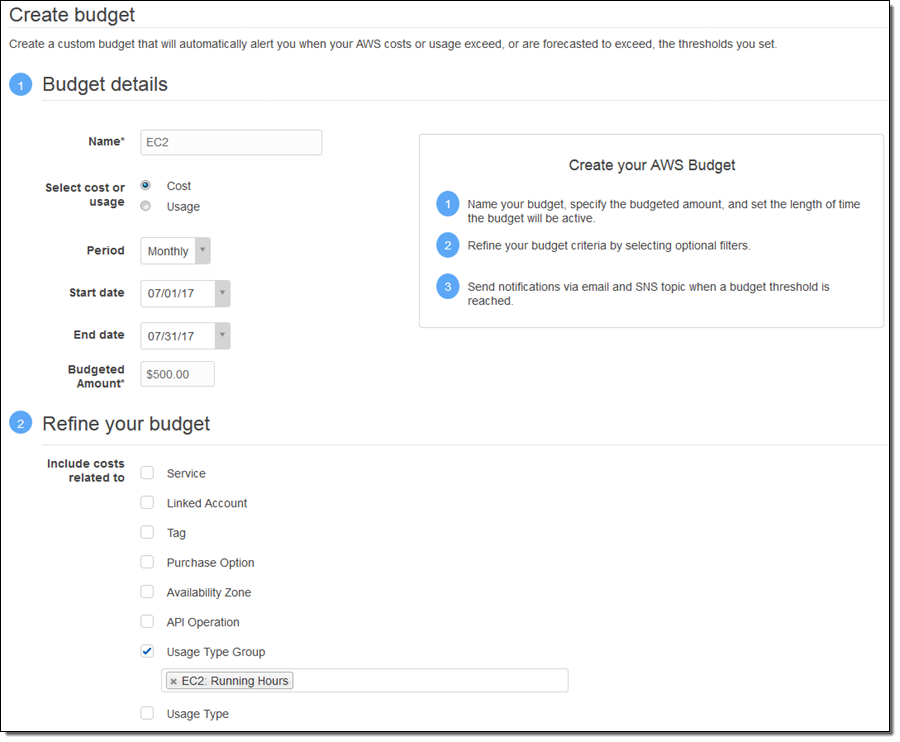
Or a specific usage type, in this case three different sizes of T2 instances:
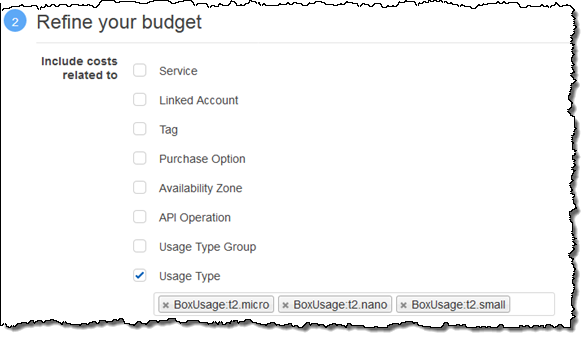
EC2 Systems Manager Support for Hierarchies, Tagging, and CloudWatch Events
This management service helps you to automatically collect software inventory, apply OS patches, create system images, and configure both Linux and Windows operating systems.
The Parameter Store (one of the service’s most popular features) stores configuration data such as database access strings and passwords in encrypted form. It is accessible from the CLI, APIs, and SDKs; this allows AWS Lambda functions and code running inside of Amazon ECS containers to access the same parameters.
We added support for storage of parameters in hierarchical form, giving you the ability to group them by organization, application, and so forth. You can also create parallel sets of parameters for use in development, testing, and production environments. To create a hierarchy of parameters, use names that include one or more “/” characters:
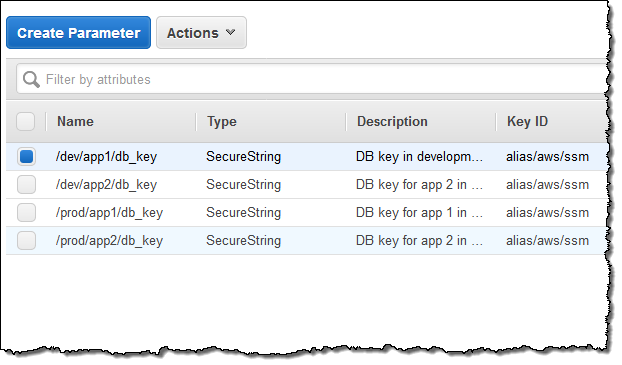
We also added support for tagging. You can query parameters based on tags and you can add IAM permissions to parameters via tags.
Finally, the Parameter Store is now a source of CloudWatch Events. You can now track changes to your parameters, perhaps making sure that they are not inadvertently changed in a way that could break an existing application:

Keeping Up
In addition to reading this blog on a regular basis, you can also follow me and AWS Cloud on Twitter. You can also check out the AWS What’s New and subscribe to the RSS Feed.
— Jeff;
Amazon Pinpoint – Hit your Targets with AWS
My colleague Georgie Mathews wrote the guest post below to introduce you to Amazon Pinpoint, a new service that helps you to measure and improve user engagement for your mobile apps.
— Jeff;
Our mobile customers have told us how expensive it can get to acquire new users for their apps. Then there is the challenge of retaining those users and encouraging them to use the app frequently. To help keep users coming back, app companies run engagement campaigns using push notifications. These campaigns can vary depending on the app. For example, game developers may send users an in-app notification with new level hints and bonuses if they are stuck on one level for too long, or retailers send users promotional information in the event of a sale or if they haven’t opened the app recently.
Measuring and constantly improving targeted push notification campaigns is essential to increasing user engagement. Sending too many, or untimely notifications can cause users to turn them off or even uninstall the app. Push notification campaigns that are targeted based on app usage trends and user behavior increases message relevance and effectiveness, while helping app developers define and measure messaging benchmarks for campaigns.
Previously, if you wanted to engage users with targeted push notification campaigns, you either used a third-party service, or you had to build your own targeting solutions. Building your own in-house campaign management solution also meant you had to manage scalability, feature support, and maintenance.
Introducing Amazon Pinpoint
Today we are launching Amazon Pinpoint, a new service that makes it easy to run targeted campaigns to improve user engagement. Pinpoint helps you understand your users’ behavior, define who to target, what messages to send, when to deliver them, and tracks the results of the campaign.
Pinpoint enables real-time analytics with dashboards for analyzing user engagement, monetization, user demographics, custom events, and funnels so you can understand how users engage with your application. You can analyze and understand your user data by drilling down based on the segments you’ve defined, segmentation attributes, or time.
With Pinpoint, you can define target segments from a variety of different data sources. You can identify target segments from app user data collected in Pinpoint. You can build custom target segments from user data collected in other AWS services such as Amazon S3 and Amazon Redshift, and import target user segments from third party sources such as Salesforce via S3.
Once you define your segments, Pinpoint lets you send targeted notifications with personalized messages to each user in the campaign based on custom attributes such as game level, favorite team, and news preferences for example. Amazon Pinpoint can send push notifications immediately, at a time you define, or as a recurring campaign. By scheduling campaigns, you can optimize the push notifications to be delivered at a specific time across multiple time zones. For your marketing campaigns Pinpoint supports Rich Notifications to enable you to send images as part of your campaigns. We also support silent or data notifications which allow you to control app behavior and app config on the background.
Once your campaign is running, Amazon Pinpoint provides metrics to track the impact of your campaign, including the number of notifications received, number of times the app was opened as a result of the campaign, time of app open, push notification opt-out rate, and revenue generated from campaigns. You can also export the resulting event data and run custom analytics using your existing analytics systems. You can also A/B test different messages, track results, and then send the best message to your target segment.
With Pinpoint there is no minimum fee, no setup cost and no fixed monthly cost based on your total user pool. You only pay for the number of users you target or collect events from, the messages you send, and events you collect, so you can start small and scale as your application grows.
Now lets take a look at how Pinpoint makes it easy to setup a campaign.
Create a new Mobile Hub project from the AWS Mobile Hub console:

Choose Add User Engagement and enable app and campaign analytics by clicking Enable Engagement and add your GCM/FCM and APNS credentials.
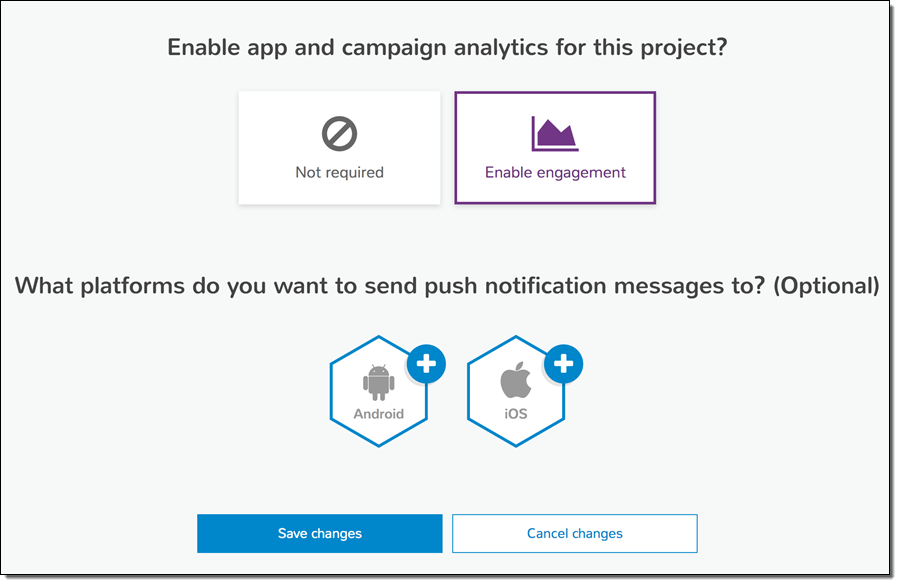
See integration steps for User Engagement within the Integrate section of Mobile Hub.
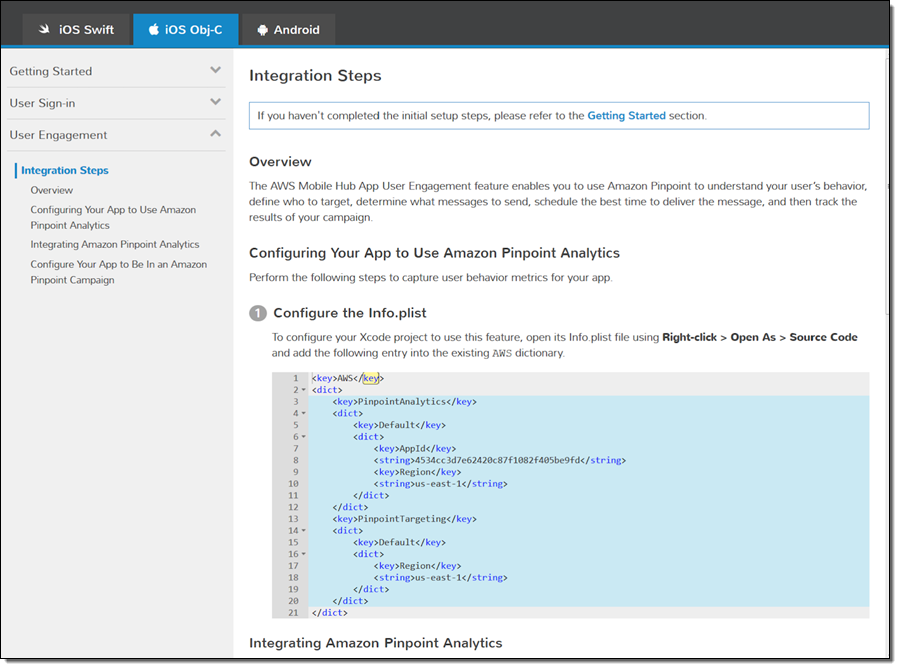
Once you are completed with integration steps in Mobile Hub. Next, head over to the Pinpoint console where you will see your app live.
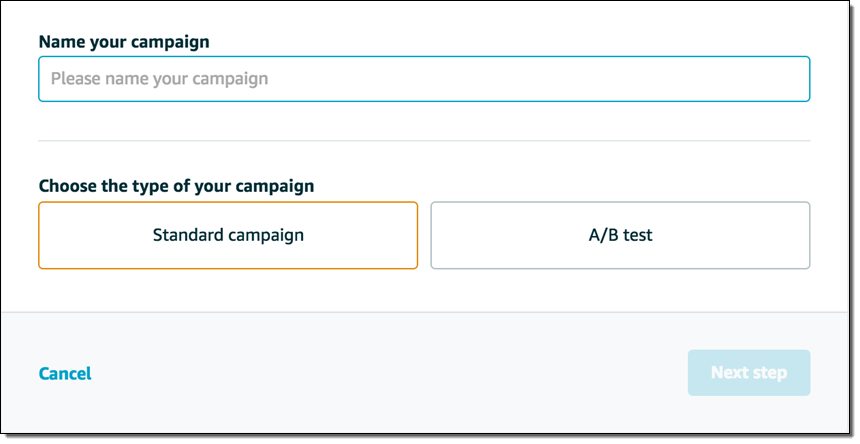
Click on Campaigns → Create Campaign:

Leave Standard Campaign selected and Click on Segment to define your targeting criteria:
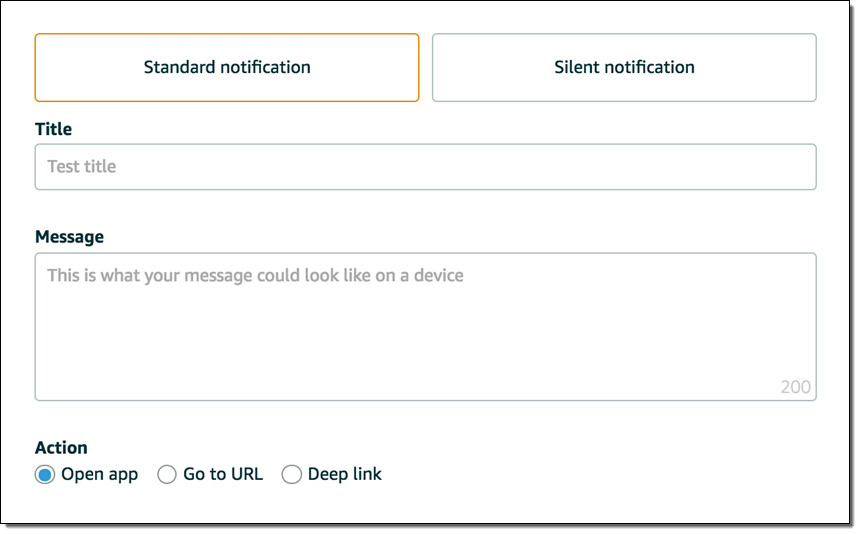
Click on Message, type in a message and click Schedule:

Choose Immediate from the drop down, click Review and Launch and then finally Launch Campaign.
You can also view your app analytics with Pinpoint using the Pinpoint Analytics dashboard:
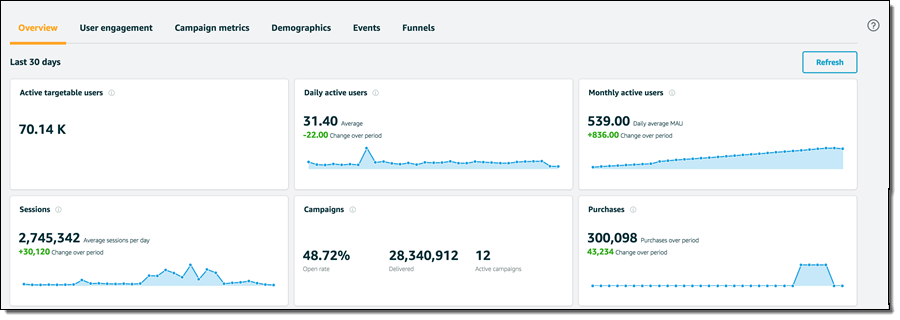
Pricing and Availability
We are launching Amazon Pinpoint today in the US East (Northern Virginia) Region, and plan to expand it to other regions in the near future. Let us know what you think!
Georgie Mathews, Senior Product Manager
Update- You can learn more about Pinpoint with our webinar on January 20th. Sign up for the webinar here.